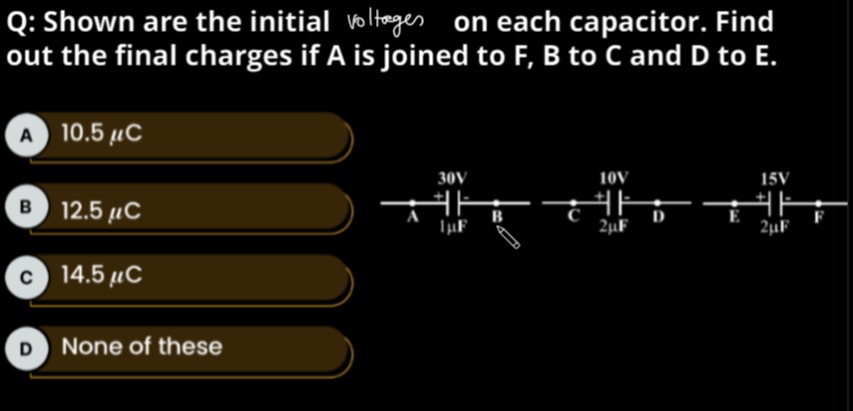Question
Question: Shown are the initial voltages on each capacitor. Find out the final charges if A is joined to F, B ...
Shown are the initial voltages on each capacitor. Find out the final charges if A is joined to F, B to C and D to E.

10.5 μC
12.5 μC
14.5 μC
None of these
12.5 μC
Solution
The initial charges on the capacitor plates are:
Q1A=+C1V1=+1μF×30V=+30μC
Q1B=−C1V1=−1μF×30V=−30μC
Q2C=+C2V2=+2μF×10V=+20μC
Q2D=−C2V2=−2μF×10V=−20μC
Q3E=+C3V3=+2μF×15V=+30μC
Q3F=−C3V3=−2μF×15V=−30μC
When A is joined to F, B to C, and D to E, we form three connected nodes: (A, F), (B, C), and (D, E). Let their final potentials be VAF, VBC, and VDE. The final voltages across the capacitors are:
V1f=VA−VB=VAF−VBC
V2f=VC−VD=VBC−VDE
V3f=VE−VF=VDE−VAF
The final charges on the plates are:
Q1f=C1V1f=C1(VAF−VBC) (charge on plate A)
−Q1f=−C1V1f=−C1(VAF−VBC) (charge on plate B)
Q2f=C2V2f=C2(VBC−VDE) (charge on plate C)
−Q2f=−C2V2f=−C2(VBC−VDE) (charge on plate D)
Q3f=C3V3f=C3(VDE−VAF) (charge on plate E)
−Q3f=−C3V3f=−C3(VDE−VAF) (charge on plate F)
By conservation of charge on each connected node:
Node (B, C): Initial charge Q1B+Q2C=−30+20=−10μC. Final charge −Q1f+Q2f=−C1(VAF−VBC)+C2(VBC−VDE).
−1(VAF−VBC)+2(VBC−VDE)=−10
−VAF+VBC+2VBC−2VDE=−10⟹−VAF+3VBC−2VDE=−10 (1)
Node (D, E): Initial charge Q2D+Q3E=−20+30=10μC. Final charge −Q2f+Q3f=−C2(VBC−VDE)+C3(VDE−VAF).
−2(VBC−VDE)+2(VDE−VAF)=10
−2VBC+2VDE+2VDE−2VAF=10⟹−2VAF−2VBC+4VDE=10⟹−VAF−VBC+2VDE=5 (2)
Node (A, F): Initial charge Q1A+Q3F=30+(−30)=0μC. Final charge Q1f−Q3f=C1(VAF−VBC)−C3(VDE−VAF).
1(VAF−VBC)−2(VDE−VAF)=0
VAF−VBC−2VDE+2VAF=0⟹3VAF−VBC−2VDE=0 (3)
We have the system of equations:
(1) −VAF+3VBC−2VDE=−10
(2) −VAF−VBC+2VDE=5
(3) 3VAF−VBC−2VDE=0
Adding (1) and (2): (−VAF+3VBC−2VDE)+(−VAF−VBC+2VDE)=−10+5⟹−2VAF+2VBC=−5⟹2VAF−2VBC=5 (4) Adding (2) and (3): (−VAF−VBC+2VDE)+(3VAF−VBC−2VDE)=5+0⟹2VAF−2VBC=5 (5) Equations (4) and (5) are identical, indicating linear dependence. This is expected because the sum of initial charges on all plates is 30−30+20−20+30−30=0, and the sum of final charges is Q1f−Q1f+Q2f−Q2f+Q3f−Q3f=0. Also, V1f+V2f+V3f=0.
We can use the potential of one node as a reference, say VDE=0. Then the equations become:
(1) −VAF+3VBC=−10
(2) −VAF−VBC=5
(3) 3VAF−VBC=0
From (3), VBC=3VAF. Substitute into (2): −VAF−3VAF=5⟹−4VAF=5⟹VAF=−5/4=−1.25V. Then VBC=3×(−1.25)=−3.75V. Check with (1): −(−1.25)+3(−3.75)=1.25−11.25=−10. This is consistent. So, VAF=−1.25V, VBC=−3.75V, VDE=0V.
The final voltages across the capacitors are:
V1f=VAF−VBC=−1.25−(−3.75)=−1.25+3.75=2.5V.
V2f=VBC−VDE=−3.75−0=−3.75V.
V3f=VDE−VAF=0−(−1.25)=1.25V.
The final charges on the positive plates are:
Q1f=C1V1f=1μF×2.5V=2.5μC.
Q2f=C2V2f=2μF×(−3.75V)=−7.5μC.
Q3f=C3V3f=2μF×1.25V=2.5μC.
The magnitudes of the final charges are ∣Q1f∣=2.5μC, ∣Q2f∣=7.5μC, ∣Q3f∣=2.5μC. The sum of the magnitudes is 2.5+7.5+2.5=12.5μC. Therefore, the final answer is the sum of magnitudes of final charges.
